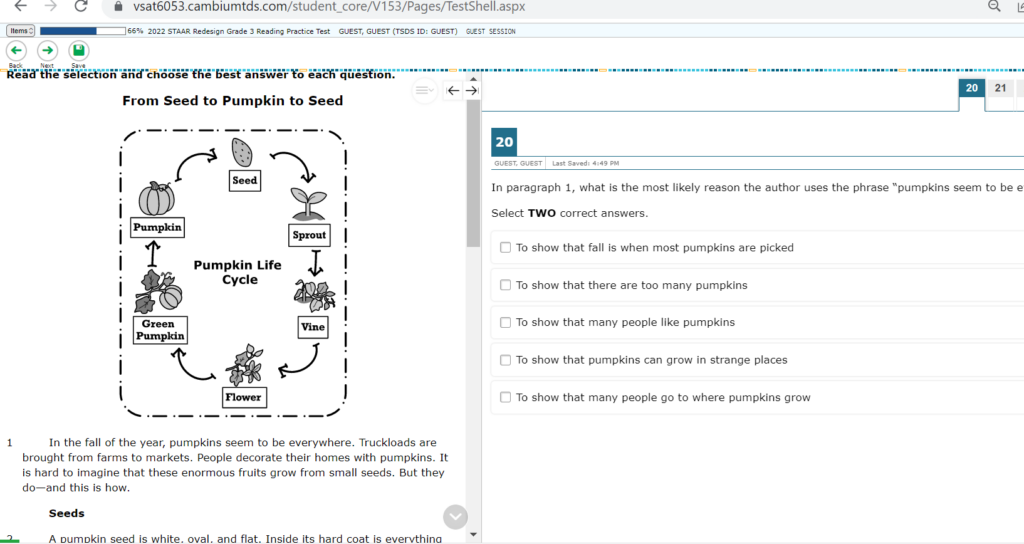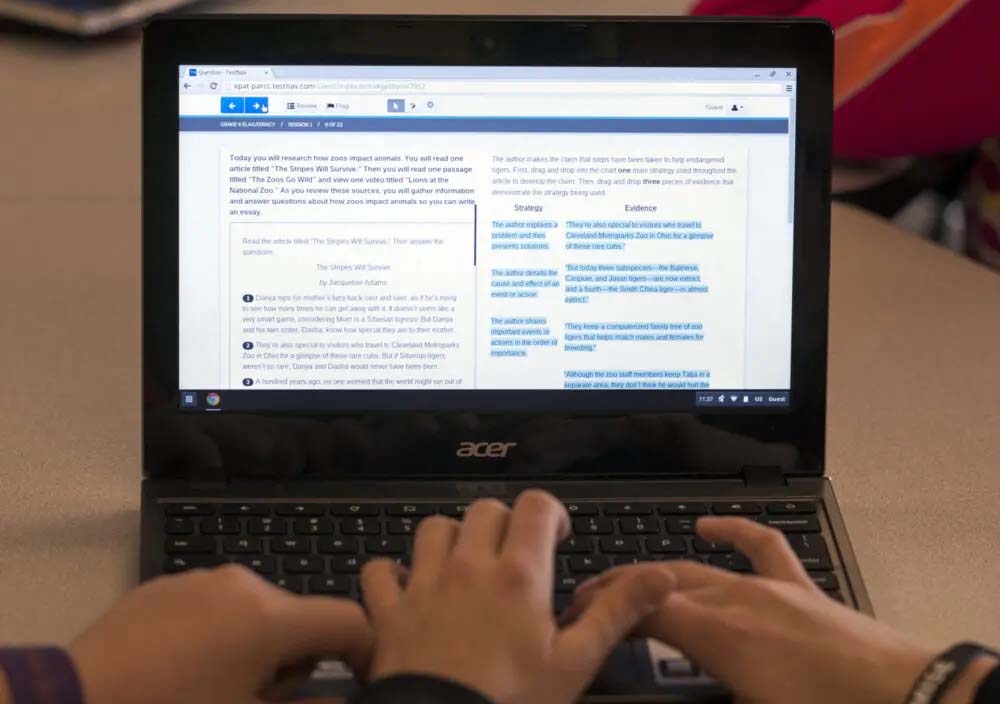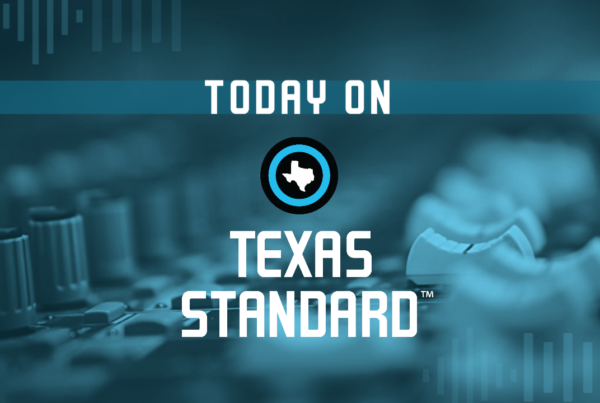From Houston Public Media:
It’s test prep season across Texas, and public school teachers are even more stressed than normal as they prepare students for the first fully online standardized tests this spring.
Some of the questions look familiar.
From the 5th grade science practice exam: “How many planets in the solar system are farther from the Sun than Jupiter?”
That’s a typical multiple choice question with one correct answer. After Jupiter, the only planets are Saturn, Uranus and Neptune (Pluto is a dwarf planet).

A practice test shows the new format of the STAAR standardized testing. This year will be the first time it is fully online.
Under the 2019 state law that mandated the virtual move, those familiar multiple choice questions will make up no more than 75% of the new test. For the other part, there’s an array of more than a dozen new question formats, like drop down menus, multiple choice questions with more than one right answer, drag and drops, and — another big change — writing prompts, for all grade levels.
In another question from the 5th grade science practice test, students read about the striped skunk and the giant panda, then answer this question: “What are two likely reasons why the striped skunk has a much greater population in the wild than the giant panda?”
That question asks for a “short constructed response,” basically a few sentences or a paragraph.
There are also essay prompts. In the 3rd grade reading practice exam, students read an article about pumpkins, then: “Explain how bees and pumpkins are beneficial to one another. Write a well organized informational essay that uses specific evidence from the article to support your answer.”
Again, this is a big change. Previously, writing was its own exam for 4th and 7th graders. Now, all grade levels that take the STAAR will see writing questions, sometimes across multiple subjects.
Lily Laux is deputy commissioner of school programs with the Texas Education Agency, which oversaw the redesign. STAAR 2.0 is supposed to be more holistic than previous exams.
“In general, this idea of kids being able to show work and demonstrate what they’re actually understanding is where the new questions are headed,” she said.
According to Laux, the test won’t be harder because there’s a balance in the amount of easy and difficult questions, based on field testing and teacher input.
But educators are stressed.
Brian Woods is superintendent of Northside ISD in San Antonio and president of the Texas School Alliance.
“Teaching an eight year old to manipulate that software so that they get what they need in order to be able to prove what they know — that’s a whole other thing that’s been added to teachers’ plates,” he said.
He said the online format can be good, though.
“I think that it’s not all bad to move to virtual testing,” Woods said. “There are reasons to do it. For instance, you do get results back much quicker on an online test than you would on a standard paper pencil test … for the most part, I think we can prepare students to transition. Now in year one, it’s going to be a heck of a transition, right?”
And again, this is a huge workload for teachers who are already stressed.
“Teachers themselves feel defeated,” said Rodrigo Cantu, a math instructional coach at the Jubilee Academies charter network in San Antonio.
As Cantu pointed out, educators are still trying to catch students up from the massive learning losses of the pandemic while also preparing kids for the redesigned STAAR.
And not every student has a computer at home.
“The students that we service don’t have all the resources provided to them,” Cantu said. “They didn’t have private tutors, they didn’t have access to parents that are knowledgeable in the content, they didn’t have this bevy of resources that students in more affluent school districts and neighborhoods have had this whole time.”
In Houston ISD, Erika De La Rosa teaches 7th grade English.
The addition of writing across subjects and grade levels isn’t a big deal for her. She’s been teaching for eight years, and her 7th graders already had to take a STAAR writing exam. But that’s not the case for every teacher, and professional development (PD) is limited.
“With the redesign, there is more writing in this so it’s spread out, and so teachers who are not used to incorporating writing into their assessments are unsure of how to do this,” she said. “It’s one of those things where you get like one PD at the beginning of the year, ‘This is what you’re going to see … and incorporate writing in all of your lessons,’ but teachers who have never done that don’t know how to do that.”
Another concern on everyone’s mind: Will the tech work?
Two years ago, an optional online version of the STAAR crashed. The Texas Education Agency described the situation as “completely unacceptable” and blamed the test vendor, Educational Testing Service.
Lily Laux with TEA pointed to an important change.
“We have an entirely new vendor,” she said. “We have done some really extensive load testing … I can share with confidence, again, that we feel great about the changes that have been made since then.”
She also said districts have had plenty of time and state resources to ramp up infrastructure — but past experiences have teachers worried.
“I think the biggest concern is: will the internet, will the software, will all of the technology be able to support the whole district on something at once,” De La Rosa said. “Which we’ve tried in the past, and it has been super glitchy.”
The tech-heavy approach is also a concern for students in special education, who might do better with a paper test. Parents with students who need that or other accommodations should make sure it’s outlined in the Individualized Education Plan (IEP).
“If they have it in their IEP, we will make sure that a student has a paper test,” Laux said.
So, if your child’s IEP doesn’t include needed accommodations, request a meeting with your school to update the plan before spring.
Students in elementary and middle schools can feel less stressed about this year’s test. As Laux pointed out, grade level promotions before high school are no longer tied to the exams.
“I do think it’s really important for folks to know that it is not a high-stakes test, and that there are no student-level consequences for STAAR,” she said. “I think a lot of times we hear that misconception — ‘why are we putting this pressure on kids.’ In fact, there’s no no kid-level consequences for this.”
But the test remains high-stakes for teachers — whose performance ratings and pay are often determined by standardized test scores — and for schools and districts. Houston ISD is still facing a potential state takeover due to years of failing accountability ratings at one campus. If other districts have even one school where students don’t perform well on the redesigned STAAR for several years, they could face the same outcome.














